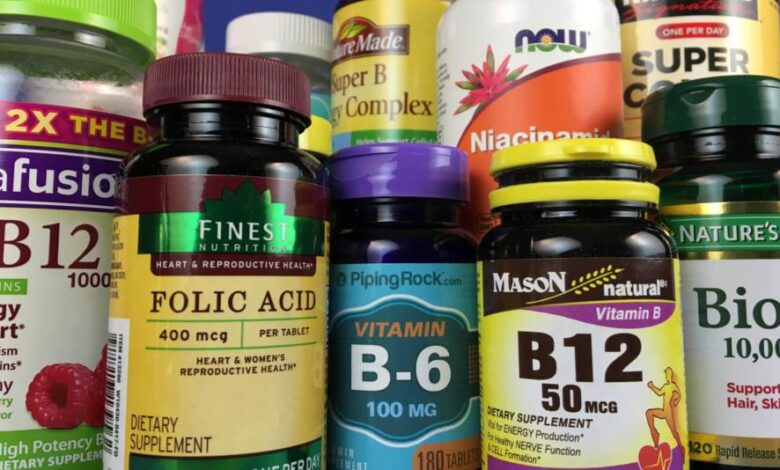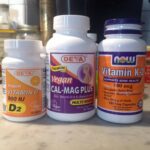How Long Does It Take For Vitamins To Work?

A vitamin is an organic molecule that is an essential micronutrient which an organism needs in small quantities for the proper functioning of its metabolism. Essential nutrients cannot be synthesized in the organism, either at all or not in sufficient quantities, and therefore must be obtained through the diet.
Vitamins have different jobs to help keep the body working properly. Some vitamins help you resist infections and keep your nerves healthy, while others may help your body get energy from food or help your blood clot properly. By following the Dietary Guidelines, you will get enough of most of these vitamins from food.
Types of Vitamins, Sources and their Function
Water-soluble vitamins: Water-soluble vitamins travel freely through the body, and excess amounts usually are excreted by the kidneys. The body needs water-soluble vitamins in frequent, small doses. These vitamins are not as likely as fat-soluble vitamins to reach toxic levels. But niacin, vitamin B6, folate, choline, and vitamin C have upper consumption limits. Vitamin B6 at high levels over a long period of time has been shown to cause irreversible nerve damage.
A balanced diet usually provides enough of these vitamins. People older than 50 and some vegetarians may need to use supplements to get enough B12.
| Water-soluble vitamins | ||
| Nutrient | Function | Sources |
| Thiamine (vitamin B1) | Part of an enzyme needed for energy metabolism; important to nerve function | Found in all nutritious foods in moderate amounts: pork, whole-grain or enriched bread and cereals, legumes, nuts, and seeds |
| Riboflavin (vitamin B2) | Part of an enzyme needed for energy metabolism; important for normal vision and skin health | Milk and milk products; leafy green vegetables; whole-grain, enriched bread, and cereals |
| Niacin (vitamin B3) | Part of an enzyme needed for energy metabolism; important for the nervous system, digestive system, and skin health | Meat, poultry, fish, whole-grain or enriched bread and cereals, vegetables (especially mushrooms, asparagus, and leafy green vegetables), peanut butter |
| Pantothenic acid | Part of an enzyme needed for energy metabolism | Widespread in foods |
| Biotin | Part of an enzyme needed for energy metabolism | Widespread in foods; also produced in the intestinal tract by bacteria |
| Pyridoxine (vitamin B6) | Part of an enzyme needed for protein metabolism; helps make red blood cells | Meat, fish, poultry, vegetables, fruits |
| Folic acid | Part of an enzyme needed for making DNA and new cells, especially red blood cells | Leafy green vegetables and legumes, seeds, orange juice, and liver; now added to most refined grains |
| Cobalamin (vitamin B12) | Part of an enzyme needed for making new cells; important to nerve function | Meat, poultry, fish, seafood, eggs, milk, and milk products; not found in plant foods |
| Ascorbic acid (vitamin C) | Antioxidant; part of an enzyme needed for protein metabolism; important for immune system health; aids in iron absorption | Found only in fruits and vegetables, especially citrus fruits, vegetables in the cabbage family, cantaloupe, strawberries, peppers, tomatoes, potatoes, lettuce, papayas, mangoes, kiwifruit |
Fat-soluble vitamins: Fat-soluble vitamins are stored in the body’s cells and are not excreted as easily as water-soluble vitamins. They do not need to be consumed as often as water-soluble vitamins, although adequate amounts are needed. If you take too much of a fat-soluble vitamin, it could become toxic. Your body is especially sensitive to too much vitamin A from animal sources (retinol) and too much vitamin D. A balanced diet usually provides enough fat-soluble vitamins.
| Fat-soluble vitamins | ||
| Nutrient | Function | Sources |
| Vitamin A (and its precursor*, beta-carotene) *A precursor is converted by the body to the vitamin. | Needed for vision, healthy skin and mucous membranes, bone and tooth growth, immune system health | Vitamin A from animal sources (retinol): fortified milk, cheese, cream, butter, fortified margarine, eggs, liver Beta-carotene (from plant sources): Leafy, dark green vegetables; dark orange fruits (apricots, cantaloupe) and vegetables (carrots, winter squash, sweet potatoes, pumpkin) |
| Vitamin D | Needed for proper absorption of calcium; stored in bones | Egg yolks, liver, fatty fish, fortified milk, fortified margarine. When exposed to sunlight, the skin can make vitamin D. |
| Vitamin E | Antioxidant; protects cell walls | Polyunsaturated plant oils (soybean, corn, cottonseed, safflower); leafy green vegetables; wheat germ; whole-grain products; liver; egg yolks; nuts and seeds |
| Vitamin K | Needed for proper blood clotting | Leafy green vegetables such as kale, collard greens, and spinach; green vegetables such as broccoli, brussels sprouts, and asparagus; also produced in the intestinal tract by bacteria |
How Long Does It Take For Vitamins To Work?
There are several factors that can determine how fast a vitamin supplement works this implies that these rates will be different for everybody. Some of these factors are a function of the person taking the nutrient and are dependent on an individual’s age, digestive system integrity, the overall state of health, gender, whether the supplements are taken on a full or empty stomach, and even the time of day.
People whose nutrient needs are greater – such as growing children, pregnant or lactating women, and those who are currently deficient – may have significantly enhanced absorption rates for certain nutrients. Even absorption of minerals from food sources can vary significantly. Boron, molybdenum, and iodine can be absorbed at over 90 percent, while the average absorption rates of zinc, copper, and selenium can range from 30 to 80 percent.
It should seem reasonable, then, that stating an overall absorption rate on a package or in advertising can be misleading.
Generally, the major factors that can determine how long it takes for a vitamin to work include:
Absorption rate
Essentially, all vitamin absorption occurs in the small intestine. Absorption of vitamins in the intestine is critical in avoiding deficiency states, and impairment of intestinal vitamin absorption can result from a number of factors, including intestinal disease, genetic disorders in transport molecules, excessive alcohol consumption, and interactions with drugs.
Absorption of Water-soluble Vitamins: As the name suggests, a water-soluble vitamin is one that dissolves in water—and as a result, is easily absorbed into the tissues of the body and metabolized more quickly than fat-soluble vitamins. Most water-soluble vitamins are available for intestinal absorption from two sources:
1) the diet, and
2) synthesis by microbes in the large intestine or, in the case of ruminants, the rumen.
These dual-origin vitamins include biotin, folic acid, pantothenic acid, riboflavin, and thiamin. Water-soluble vitamins of dietary origin are absorbed predominantly in the small intestine, whereas those synthesized by microbes in the large intestine are absorbed there. For most of these vitamins, specific carrier-mediated transport systems have been identified that allow uptake from the intestinal lumen into the enterocyte and for export from the basolateral surface of the enterocyte. Some of these transporters are sodium-dependent, while others are not.
Absorption of Fat-soluble Vitamins: The fat-soluble vitamins A, D, E, and K are absorbed from the intestinal lumen using the same mechanisms used for absorption of other lipids. In short, they are incorporated into mixed micelles with other lipids and bile acids in the lumen of the small intestine and enter the enterocyte largely by diffusion. Within the enterocytge, they are incorporated into chylomicrons and exported via exocytosis into the lymph.
Level of Nutritional Deficiency
One of the biggest factors that dictate how long it takes before a vitamin supplement kicks in is how nutrient deficient you are, to begin with. The process of assessing the nutritional status of an individual is simply a matter of determining in which of these five categories they fall for each essential nutrient.
• A state of negative balance can develop for reasons other than just poor intake
This explains why the correlation coefficients between the intake of a nutrient and the blood level of the same nutrient are often very low especially in older people
• Mild deficiencies are much more prevalent than severe ones
Many doctors are only familiar with the clinical picture of severe deficiency and will easily overlook a mild deficiency
• The symptoms of nutritional deficiency precede the signs
Physical signs of deficiency are less prevalent than the symptoms of the deficiency
• A biochemically-diagnosed deficiency (which reflects a decline in tissue stores) will precede the development of a loss in tissue function
Not all “deficiencies” diagnosed by laboratory methods alone result in a loss of function
• Death is the terminal consequence of some deficiencies
Deficiencies develop for a reason and all the reasons fall into one of five categories of causes that result in a state of negative nutrient balance:
• Inadequate Intake
• Poor Absorption
• Increased Requirement
• Increased Losses
• Altered Metabolism
All these factors combine to affect how fast a vitamin works.
Dosage of Vitamin taken
The dosage of the vitamin can determine how fast it works. When you’re taking any kind of vitamin, it’s important to stick as close to the correct dose as you can.
Overdosing. Many vitamins are good for you if used correctly, but start to become harmful if you take too much. If you take vitamins in high doses, it can cause dangerous side effects. For example, the main consequence of vitamin D toxicity is a buildup of calcium in your blood (hypercalcemia), which can cause nausea and vomiting, weakness, and frequent urination. Vitamin D toxicity might progress to bone pain and kidney problems, such as the formation of calcium stones.
Quality of Vitamins
The Food and Drug Administration (FDA) does not evaluate the effectiveness, safety, or quality of dietary supplements — or the ingredients in them — before they enter the marketplace. This is important to realize, as it means that there is no guarantee the product contains what it claims to. Furthermore, a product may even contain varying amounts of ingredients from batch to batch.
A well-made tablet provides a very effective delivery system and is the chosen form of most quality multivitamins and pharmaceutical medications. Tableted products allow for a higher level of active ingredients – almost 3 times as much as a capsule and much more than a liquid or spray. In general, the stability of tablets is also superior to liquids.





